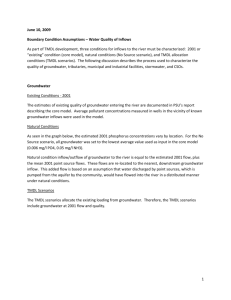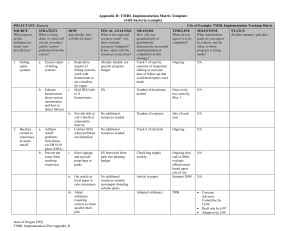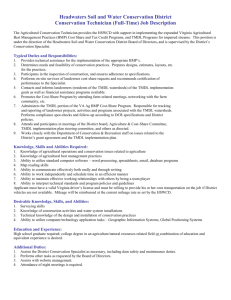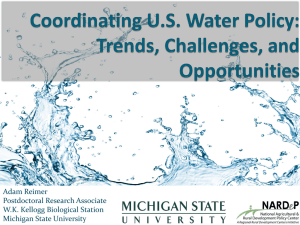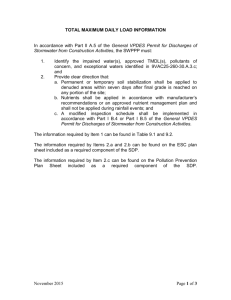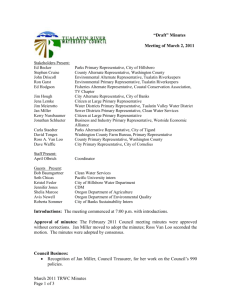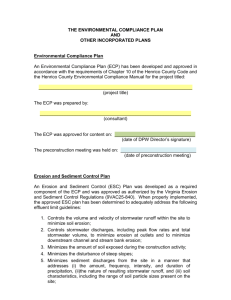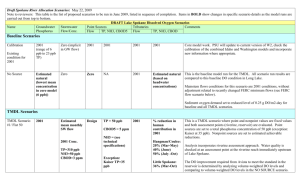narrative-description-of-boundary
advertisement
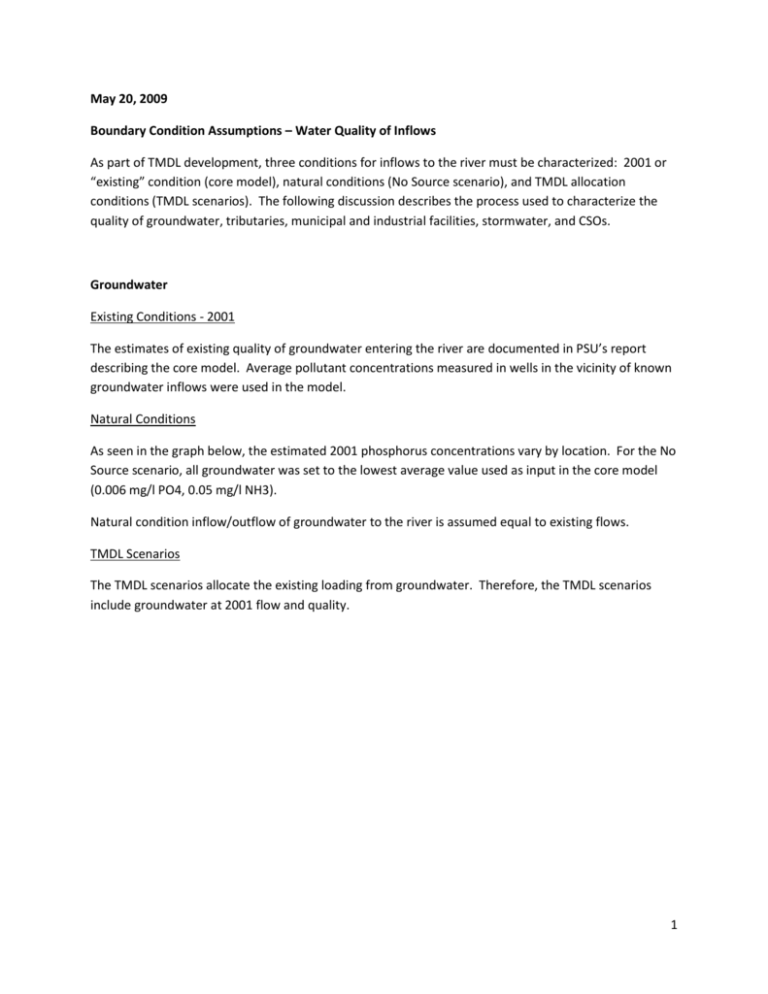
May 20, 2009
Boundary Condition Assumptions – Water Quality of Inflows
As part of TMDL development, three conditions for inflows to the river must be characterized: 2001 or
“existing” condition (core model), natural conditions (No Source scenario), and TMDL allocation
conditions (TMDL scenarios). The following discussion describes the process used to characterize the
quality of groundwater, tributaries, municipal and industrial facilities, stormwater, and CSOs.
Groundwater
Existing Conditions - 2001
The estimates of existing quality of groundwater entering the river are documented in PSU’s report
describing the core model. Average pollutant concentrations measured in wells in the vicinity of known
groundwater inflows were used in the model.
Natural Conditions
As seen in the graph below, the estimated 2001 phosphorus concentrations vary by location. For the No
Source scenario, all groundwater was set to the lowest average value used as input in the core model
(0.006 mg/l PO4, 0.05 mg/l NH3).
Natural condition inflow/outflow of groundwater to the river is assumed equal to existing flows.
TMDL Scenarios
The TMDL scenarios allocate the existing loading from groundwater. Therefore, the TMDL scenarios
include groundwater at 2001 flow and quality.
1
Human Caused
Natural
Tributaries
Existing Conditions - 2001
The estimates of 2001 flow and water quality for the three tributaries (Hangman Creek, Coulee Creek,
and Little Spokane River) are documented in PSU’s report describing the core model. Coulee Creek is
small relative to the other two tributaries. For the core model and all TMDL analyses, the pollutant
concentrations for Coulee Creek are set equal to Hangman Creek concentrations.
Natural Conditions
Pollutant concentrations in the headwaters of Hangman Creek and Little Spokane River are used as
estimates of the natural water quality of these streams. Year-round measurements are available for the
Scotia monitoring location near the headwaters of the Little Spokane River. These values were input
directly into the No Source model setup. For Hangman Creek, only limited data are available for the
Calif monitoring location near the headwaters of Hangman Creek (Jan to March, Oct to Dec).
Nevertheless, these samples are the best available information. To fill the gaps in the total phosphorus
data at Calif, the monthly 2001 conditions were scaled down by 60% until the winter and fall
concentrations approximated the concentrations measured at the Calif site (under the assumption that
human caused increases in phosphorus follow the same pattern as natural variation). This extrapolation
provides a common seasonal pattern for phosphorus between the no source and 2001 conditions, which
also provides a consistent baseline for TMDL allocations below.
2
TMDL Scenarios
The TMDL scenarios require a percent reduction in tributary concentrations which are based on
Ecology’s technical analysis for the draft Hangman sediment TMDLs. To determine the average monthly
concentration of human-caused pollution, the natural background concentrations are subtracted from
the existing (2001) concentrations. The percent reductions are then applied to the human-caused
portion of the pollution in order to identify the monthly average “allowable” human increase in
pollution, expressed in units of concentration.
The equation defining the TMDL condition is the following:
TMDL conc. = (2001 conc.) – {(% reduction)*(2001 conc. – No Source conc.)}
The % reductions proposed for each tributary are the following:
Hangman/Coulee:
20% (Mar-May)
40% (June)
50% (July -Oct)
Little Spokane:
36% (Mar-Oct)
3
TP (ppm)
Hangman Creek TMDL Scenarios
Total Phosphorus
0.150
0.140
0.130
0.120
0.110
0.100
0.090
0.080
0.070
0.060
0.050
0.040
0.030
0.020
0.010
0.000
No Source
TMDL
2001
0
30
60
90
120
150
180
210
240
270
300
330
360
390
Julian Day
Municipal and Industrial Facilities
Existing Conditions - 2001
The core model includes time-varying, 2001 discharges from permitted point sources, based on flow and
discharge quality data collected by the facilities.
Natural Conditions
Municipal and industrial discharge flows are set to zero for the No Source scenario.
TMDL Scenarios
The TMDL model scenarios include the municipal discharges at 2027 design flows to account for
predicted future growth, while industrial sources at current design flows.
Effluent quality for the TMDL scenarios is set at the estimated “limit of technology” level for each facility
and each oxygen-demanding pollutant. Except for a scenario that includes a seasonally-variable limit for
4
city of Hayden, all pollutant concentrations are set at a constant value for the entire March through
October period.
Stormwater
Existing Conditions - 2001
The core model does not include explicit stormwater discharges, due to the lack of specific information
for 2001, as well as rainfall data indicating that stormwater loadings were not a significant factor in 2001
water quality conditions (compared to point sources, tributaries and groundwater). Based on the need
to establish a quantified stormwater allocation in the TMDL, additional analysis has been conducted
since completion of the core model (see below).
Natural Conditions
Stormwater flow is set to zero for the No Source scenario.
TMDL Scenarios
The model scenarios for the TMDL condition include the addition of explicit stormwater discharges for
both Idaho and Washington. It is not feasible to identify and include all outfall pipes in the model, so
these discharges are simplified as a single pipe discharge at the downstream end of the cities of Spokane
and Coeur d’Alene.
The pollutant concentrations in stormwater are estimated using data supplied by the City of Spokane.
The average total phosphorus concentration in this urban stormwater is estimated at 0.31 mg/l.
The proposed TMDL allocates the existing loading from stormwater. Unlike groundwater and point
sources, stormwater flow is highly variable and has a unique flow pattern each year. To develop a
conservative and “generic” stormwater allocation (one not tied to low flows and random events of
2001), the daily mean flow (estimated from March to October mean precipitation) was used as a
constant flow input in the model. The mean is used under the assumption that an average precipitation
year could occur during a low base flow year like 2001. This assumption and other technical
assumptions in the calculation of the runoff are elements of the margin of safety.
Combined Sewer Overflows (CSOs)
Existing Conditions - 2001
CSOs, like stormwater, were not included in the core model, due to the lack of specific information for
2001 and a determination that stormwater loadings were not a significant factor in 2001 water quality
5
conditions (compared to point sources, tributaries and groundwater). Nevertheless, during major
storms in Spokane, combined sewers are expected to overflow and discharge to the river. Based on the
need to establish a quantified CSOs allocation in the TMDL, additional analysis has been conducted since
completion of the core model. This analysis relies on city of Spokane estimates of the average discharge
and pollutant concentrations from CSOs.
Natural Conditions
CSO flow is set to zero for the No Source scenario.
TMDL Scenarios
The proposed TMDL allocates the existing loading from CSOs. Like stormwater, CSO flow is highly
variable and has a unique flow pattern each year, and the TMDL scenario includes the daily mean flow
(scaled to the March to October period from the city’s annual estimates). The mean is used under the
assumption that an average precipitation year could occur during a low base flow year like 2001. This
assumption is an element of the margin of safety.
Supporting information
Groundwater
–Spokane County groundwater data, PSU model development reports
Tributaries
– Ecology water quality data, PSU model development reports, spreadsheets for estimation of natural
condition and TMDL condition, proposed Hangman Creek TMDL, USGS flow data
Municipal and Industrial Facilities
– Facility monitoring data and growth predictions, EPA memo on phosphorus treatability.
Stormwater
– Simple method for flow estimation(available online links), spreadsheet for flow calculations, City of
Spokane discharge quality data, basin impervious area from USGS aquifer study, National Weather
Service precipitation data, EPA NURP study
CSOs
6
– City of Spokane CSO flow and discharge quality data, National Weather Service precipitation data
7

